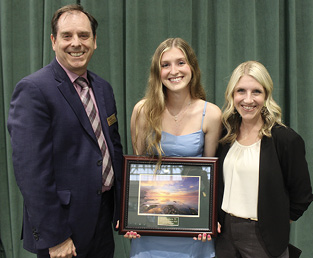Vadoud Niri of the chemistry faculty and his undergraduate assistants worked steadily—and quietly—for three years researching five common houseplants as agents for removing potentially hazardous chemicals such as acetone from the air. Then the American Chemical Society took note of their work, and it is quiet no longer.

GREEN SOLUTION—Students Geoff Peterson ’15 M’17 (left) and Tim Jones ’17 (right) joined chemistry faculty member Vadoud Niri in the Shineman Center greenhouse to demonstrate a technique for extracting samples from houseplants, which they have spent three years investigating for effectiveness in removing potentially hazardous chemicals from the air.
Niri’s presentation at the society’s annual conference this summer—accompanied by an ACS news release and graphic animation of the experiments—attracted the attention of Washington Post columnist Sarah Kaplan in the “Speaking of Science” blog and subsequent global attention from science mass media and “green” websites worldwide.
The outburst of attention shines a strong light not only on Niri’s sustainable approach to an air-quality problem afflicting everyone from nail salon owners to homeowners, but to the outstanding opportunities for hands-on, faculty-mentored research at SUNY Oswego among undergraduates and graduate students alike.
Biofiltration’s benefits
Niri’s research on indoor plants began after a visit to a nail salon with his wife. The odor of acetone in the air quickly drove him out. Acetone is one of the volatile organic compounds (VOCs) that, if inhaled or ingested to excess, can cause health issues such as dizziness, nausea, shortness of breath, headaches, eye and throat irritation—eventually even liver and kidney damage or lung cancer.
In conducting a review of the literature on removal of VOCs from air, Niri came upon a 1980s NASA study on VOC’s absorption by houseplants, a process called biofiltration that captures and degrades pollutants.
He and his students selected five types of plants to test: jade, spider, bromeliad, Caribbean tree cactus and a palm-like shrub called dracaena. They built a chamber in SUNY Oswego’s Analytical Chemistry Research Lab in the Richard S. Shineman Center for Science, Engineering and Innovation that tested how well each plant removed the VOCs from the air.
The college’s Scholarly and Creative Activity Committee, which receives support from The Fund for Oswego, provided grants to help fund Niri’s the research, which is being submitted to a scientific journal. Following that, he said, the research must be scaled up.
“I need to emphasize that the experiments we have done have been in a lab setup,” Niri said.
“The next step is to try these exact experiments in real room-size situations.”
You might also like
More from Campus Currents
University Celebrates Third Annual Founder’s Weekend
University Celebrates Third Annual Founder’s Weekend Several hundred members of the Laker community gathered together on campus to learn about the …
SAVAC Captain, Biology Major Named 2023 Outstanding Senior Award Winner
SAVAC Captain, Biology Major Named 2023 Outstanding Senior Award Winner Shannon Harris ’23, a biology major from Webster, N.Y., was selected …












